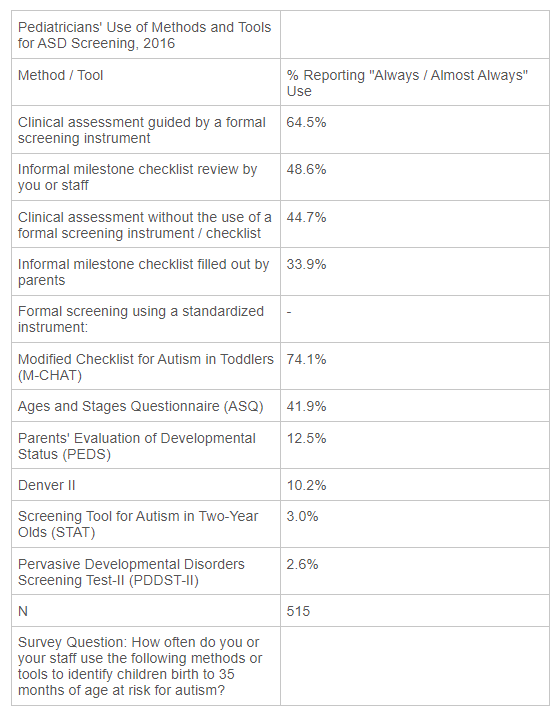Daniel Coury5, Audrey Wolfe7, Paul H. Lipkin3, Briella Baer8, Susan L. Hyman6, Susan E. Levy2, Michelle M. Macias4, Blake Sisk1.
1Research, American Academy of Pediatrics, Elk Grove Village, IL; 2Developmental Pediatrics, Children's Hospital of Philadelphia, Philadelphia, PA; 3Medical Informatics, Kennedy Krieger Institute, Baltimore, MD; 4Pediatrics, Medical University of South Carolina, Charleston, SC; 5Nationwide Children's Hospital, Columbus, OH; 6Pediatrics, University of Rochester, Rochester, NY; 7General Pediatrics, Massachusetts General Hospital for Children, Boston, MA; 8Kennedy Krieger, Baltimore, MD.
Presented at the 2017 Pediatric Academic Societies Annual Meeting.
Background: Research shows that early identification of children with autism spectrum disorder (ASD) as well as intensive, early intervention during the toddler and preschool years improves outcomes. Current guidelines recommend screening all children for ASD with a standardized tool at 18 and 24 months of age.
Objective: To better understand practice behavior of general pediatricians in the U.S. around screening and diagnosis of ASD in children <36 months of age.
Methods: The Autism Intervention Research Network on Physical Health and Autism Speaks Autism Treatment Network, in collaboration with the American Academy of Pediatrics (AAP), conducted a nationally representative survey on autism screening practice of AAP U.S. members in 2016 (N=515; response rate=47%). The survey asked about if respondents assess for developmental risk or autism, methods of identifying children at risk for ASD, frequency of use of standardized ASD screening tools, and referral practices.
Results: In 2016, 81% of pediatricians report "always/almost always" using one or more formal tools to screen for ASD. Among pediatricians screening for ASD in 2016, 74% report using the Modified Checklist for Autism in Toddlers (M-CHAT), while 45% assess for ASD without the use of a formal screening instrument/checklist and 34% use informal developmental milestone checklists filled out by parents as an assessment tool (Table 1). When pediatricians report using a formal screening tool to assess for ASD, survey results show that 88% screen at 18 months and 74% screen at 24 months. Further, 43% reported use of a formal screening tool when surveillance indicates a concern for delayed or disordered development.
Discussion: The results indicate efforts by multiple organizations to increase routine screening for ASD have been effective, as pediatricians report screening for ASD at very high rates. Use of formal screening tools allows pediatricians to identify children at risk for ASD as well as diagnose children with ASD earlier in life, thus allowing those children earlier access to services and ultimately improving outcomes.

Last Updated
10/18/2021
Source
American Academy of Pediatrics